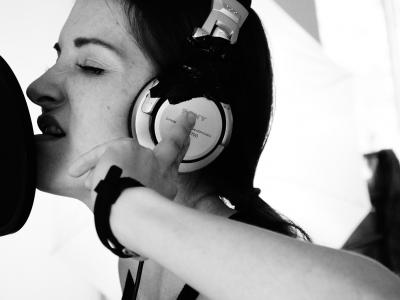You’ve been studying the greats, working on improving your vocal skills, and building vocal technique. Now it’s time to take the next step as you put yourself out there. You want to shine as a vocalist. You want to have something really special; something that stands out as uniquely you. This course will help you define the music that you want to make: What is your message? How are you different from your favorite artists? What makes you who you are?
Through the curriculum and a healthy amount of personal exploration, you will find the answers to these questions, while developing a keen ear for style to develop your sound. You’ll learn how to shape your voice for tone and style, and learn which keys suit your voice best. You’ll become more skilled at vocal technique, including breath management, placement, belting, soft singing, and other proficiencies to bring out the very best in your own voice. You’ll learn how your voice actually works anatomically in different registers. You’ll gain more mastery over your singing voice, enabling you to make artistic choices as you develop and refine your sound. You’ll learn how to work with a live rhythm section, and how a vocalist should run an effective rehearsal.
Throughout Popular Singing Styles, assignments combine interactive exercises and singing opportunities. We listen closely to songs to find out what makes them pop. We learn how to get comfortable with different accompaniments. We shape your vocal to bring out the best elements in your style, such as when to belt, or not to belt; how to use vibrato, or straight tone. We also demystify the vocalist’s secret weapon: mix voice. We explore genres such as rock, pop, R&B, and jazz, as you decide where in the spectrum of popular music you want to land as a singer.
After 12 weeks you will have built your own style toolkit, creating an individualized final project that will help you launch your singing career.
By the end of the course, you will be able to:
- Define and launch your personalized musical style
- Sing with more confidence, skill, and expression
- Lead a rhythm section confidently and effectively
- Train your ear for more accurate singing and listening skills
- Improve your vocal technique, including breathing, and belting
- Understand anatomical facts about how your voice works
Syllabus
Lesson 1: Essential Listening Skills for Learning Contemporary Songs
- How to Listen to a New Song That You Want to Learn
- Listening More Closely to the Song’s Arrangement, Beneath the Vocal
- Vocal Types
- What is Real, What is Fake
- Assignment 1: Song Analysis
Lesson 2: Training Your Ear
- Ear Training is Essential for Developing Your Sound
- How Vowel Shapes Affect Pitch and Musical Style
- Matching Pitch
- Observing Your own Singing for Accuracy and Style
- Assignment 2: Singing with a Changing Accompaniment
Lesson 3: Vocal Styles and Tone Quality, Part 1
- How Vowel Shapes Affect Tone Quality in Contemporary Styles
- Breathing Techniques
- Using Consonants and Percussive Singing for Effect
- Using Legato and Staccato, and Vibrato or Straight Tone for Effect
- Assignment 3: Singing Your Style Preference
Lesson 4: Vocal Styles and Tone Quality, Part 2
- Clean and Breathy Tones
- How Microphones Affect the Quality of the Voice
- Using Dynamics for Style
- Beginning to Identify Your Style
- Assignment 4: Clear and Breathy Tones Performance
Lesson 5: Mix Voice: A Key Ingredient for Mastering Contemporary Singing
- What is Mix Voice
- Practicing Singing with Mix Voice
- Learning When to Best use Mix Voice
- Continuing to Identify Your Style
- Assignment 5: Mixed Voice Performance
Lesson 6: Singing Powerful Styles Healthfully, Part 1
- What is Powerful Singing (Belting)
- The Vocal Anatomy of Belting
- Understanding Vocal Registers
- Agility and Flexibility
- Assignment 6: Using Powerful Singing in Your Own Style
Lesson 7: Singing Powerful Styles Healthfully, Part 2
- Approaching the Passaggio or “Break”
- Learning How Best to Practice Powerful Singing
- Artist Examples of Healthy Powerful Singing
- Implementing Powerful Singing into Your Style
- Assignment 7: Powerful Singing Performance
Lesson 8: Training Your Ear: Styles and Rhythms
- Five Most Common Rhythmic Subdivisions
- Synchronized Grooves: Singing “In the Pocket”
- Grooves
- Counting off Tunes for the Band
Assignment 8: Identifying Four Grooves, and Counting Them Off
Lesson 9: Understanding the Function of the Band or Rhythm Section
- Roles and Sounds of the Instruments
- Recognizing Essential Elements of an Arrangement
- Learn Band Speak: Effective Communication
- Leadership
Assignment 9: Performance Set List and Production Storyboard
Lesson 10: Building Your Style Toolkit
- Finding Your Best Key for a Song
- Lyrical Interpretation
- Including Improvisation and Riffing, Part 1
- Using Movement to Accentuate Singing
Assignment 10: Film Yourself Singing a Song of Your Choice
Lesson 11: Developing Your Sound: Style Awareness and Integration
- Selecting a Musical Genre for Your Stylistic Focus
- Improvisation and Riffing, Part 2
- Putting a Twist on a Cover Song
- Refining the Set List
- Assignment 11: Cover Song Performance
Lesson 12: Launching Your Sound
- Honoring Your Inspiration, Your Voice, Your Musicianship
- Three Song Demo, Song 1
- Three Song Demo, Song 2
- Three Song Demo, Song 3
- Assignment 12: Final Project - Three Song Demo
Requirements
Prerequisites and Course-Specific Requirements
Prerequisite Courses, Knowledge, and/or Skills
Completion of Voice Technique 101 or equivalent knowledge and experience.
Students should have:
- An understanding of basic vocal anatomy
- Fundamental vocal skills
- Awareness of different contemporary styles
- The ability to learn and sing back melodies accurately and in-tune
It is recommended that students also:
- Have some experience with a DAW (GarageBand, Logic Pro, Pro Tools, etc.) so they can record their vocal clearly along with a prerecorded backing track
Textbook(s)
- Belting: A Guide to Healthy, Powerful Singing by Jeannie Gagné (Berklee Press 2015)
- Your Singing Voice - Contemporary Techniques Expression and Spirit by Jeannie Gagné (Berklee Press 2012)
Recording
- Students are required to record video while performing with a backing track for their assignments. Options for recording video include:
- Smartphone
- Digital camera
- Webcam (using either video recording software, or the video recording tool that is built into the learning environment)
Software
- Recommended: Digital Audio Workstation (DAW). Free options, such as GarageBand (Mac) or Cakewalk by BandLab (PC), are acceptable.
Hardware
- Students are required to capture their vocal performance in high quality, as well as monitor audio output. Options include:
- Input (one required):
- XLR microphone suitable for singing and audio interface (recommended option)
- USB microphone suitable for singing
- Output (one required):
- Headphones (required if multitracking and/or input monitoring)
- Studio monitors and audio interface
- Built-in or external speakers
- Input (one required):
- Note: Depending on your setup, you may also need an XLR cable, microphone stand, and pop filter.
Student Deals
After enrolling, be sure to check out our Student Deals page for various offers on software, hardware, and more. Please contact support@online.berklee.edu with any questions.
General Course Requirements
Below are the minimum requirements to access the course environment and participate in Live Classes. Please make sure to also check the Prerequisites and Course-Specific Requirements section above, and ensure your computer meets or exceeds the minimum system requirements for all software needed for your course.
Mac Users
PC Users
All Users
- Latest version of Google Chrome
- Zoom meeting software
- Webcam
- Speakers or headphones
- External or internal microphone
- Broadband Internet connection
Instructors
Author & Instructor
Jeannie Gagné is a world-class vocalist who has been teaching vocal lessons and performing for more than three decades. She has sung with Philip Glass, Cher, toured with reggae legend Frankie Paul, and opened for Barenaked Ladies. She has sung on movie soundtracks and on dozens of recordings, been featured on television and radio, and travelled world-wide to teach and perform. On YouTube she's known as The Vocal Genie. Her three solo albums highlight her four-octave range and unique vocal style. Jeannie also co-founded Berklee College of Music’s Performance Wellness Institute, where she is a professor on the voice faculty. She is the author of two groundbreaking books, Your Singing Voice: Contemporary Techniques, Expression and Spirit; and Belting: A Guide to Healthy, Powerful Singing.
What's Next?
When taken for credit, Popular Singing Styles: Developing Your Sound can be applied towards the completion of these related programs:
Related Certificate Programs
Related Degree Major
Questions?
Contact our Academic Advisors by phone at 1-866-BERKLEE (U.S.), 1-617-747-2146 (INT'L), or by email at advisors@online.berklee.edu.









